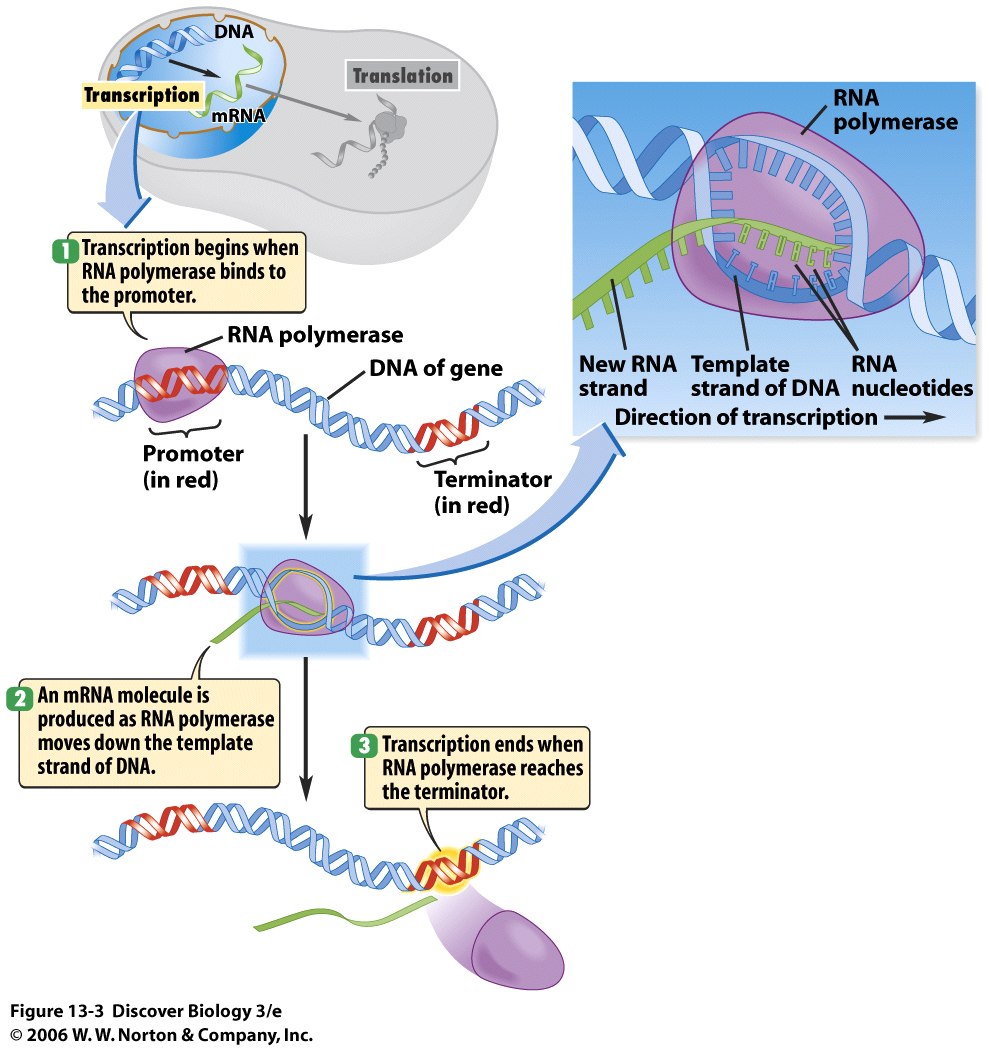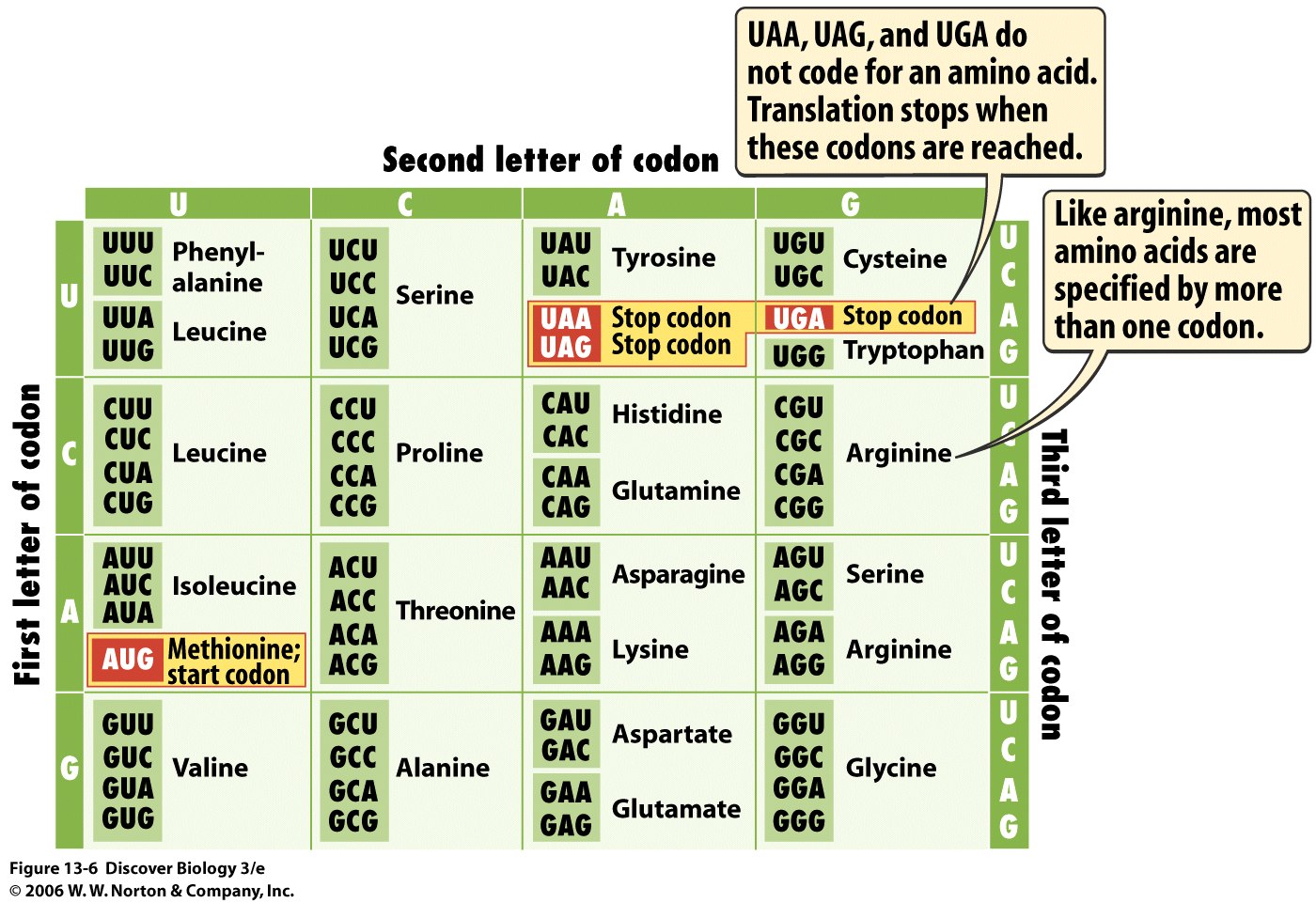
Lecture 8-9 Preview
Organelles are groups of molecules carrying out specialized functions in the cell. Different organelles work together to keep the cell alive.
Focus on Nucleus, ribosomes, rough endoplasmic reticulum.
Next Monday we will be working on presenting a pageant on how proteins are made by cells, using information in DNA. Start preparing now by reading through this preview and the background material on pages 244-257. For a dynamic view of the interacting molecules in the cell, view this animation: http://www.lewport.wnyric.org/jwanamaker/animations/Protein%20Synthesis.html.
Background: Proteins are important
molecules in organisms because they carry out so many different jobs, including
the production of other molecules. The
information for making proteins is carried in each cell’s DNA, where the
sequence of bases in a gene encodes what sequence of amino acids should be joined to make
a protein. The sequence of amino acids
joined together folds into a specific shape, which allows the protein to carry
out its specific job. Protein Synthesis
is a two-step process:
To save energy, transcription and translation of a particular gene (information for a protein in DNA) are only carried out when a particular protein is needed.
In summary,

Close up of transcription:

Close up of translation:

To review components in the processes, go to your text's website and view animations 13.4 and 13.6.
Protein Synthesis Pageant
(To be presented Monday, February 19, by the whole class)
Be able to talk about your assigned role, know the roles of others, know how you will interact with others. Completing your Homework will also help.
Assignment of Roles
If the number I gave you when I returned your first homework was
|
1-7 you area nucleotide in a DNA template strand of a gene |
|
13-19, you are a nucleotide in a DNA strand complementary to the template strand |
|
24-29, you are a nucleotide in mRNA |
|
34-39, you are a nucleotide in one of two tRNA's |
|
8-12, you are a nucleotide in rRNA |
|
20-23, you are an amino acid |
|
30-33 you are a ribosomal protein |
|
40, you are RNA polymerase |
| 41-48, you are a versatile understudy, who can take any of the above roles |
Players and their spoken parts: On Monday, each group of molecules will do a choral recitation. You can start with the script below or write your own special version as a group. Your words should help other students remember your names, your molecular nature, and what you do in protein synthesis.
Nucleotides in DNA (14, representing the billions in a cell): We form two strands or chains to make the double-stranded DNA in cells. In each strand we join together in a line by covalent bonds and have a specific sequence of bases, to form one nucleic acid chain (or strand). Our bases can be Adenine, Thymine, Guanine, or Cytosine. Our two strands are complementary (fitting together in shape and charge). A Thymine sticking out of one strand only fits with an Adenine sticking out of the complementary strand; a Guanine sticking out of one strand only fits in with a Cytosine sticking out of another strand. In the double-stranded form we are a tough molecule that can be around for millions of years.
Half of us (7 players) make up a template strand or chain, used to make RNA's that function in protein synthesis; we are the template strand.
The other half of us (7 players) make up a partner or complementary chain, which pairs with the template chain to protect it as double-stranded DNA.
· Nucleotides in RNA (17 see below, representing the millions in a cell): We join together in a line by covalent bonds and have a specific sequence of bases, to form one nucleic acid chain (or strand). Our bases can be Adenine, Uracil (in place of Thymine), Guanine, or Cytosine. Our nucleic acid chain is made using one DNA strand as a template or (complementary pattern). One pair of complementary bases is Adenine in DNA with Uracil in RNA; another is Thymine in DNA with Adenine in RNA; and the third is Guanine and Cytosine. We are not as tough as DNA, we get joined together when a certain protein is needed, then we get taken apart for recycling. We could be in
o mRNA (6) and be read as 3-base codons, each specifying a certain amino acid be placed in a chain to make a protein or
o tRNA (6) and carry a certain amino acid to the mRNA codon; my 3-base anticodon pairs up with the mRNA codon; since the codon for the amino acid met is AUG, I can only carry met if my anticodon is UAC;
o rRNA(5) and interact with specific proteins to form a ribosome where the mRNA and tRNA come together and the amino acids are joined to form a protein chain.
· RNA Polymerase (1, representing scores in a cell): I am an enzyme (you can tell by the “ase” in my name). I speed up the separation of the two DNA strands making up a gene and then speed up covalent joining of RNA nucleotides into an RNA chain, after they line up opposite the template DNA strand.
· Amino acids (4, representing thousands in a cell): We join together in a line by covalent bonds and have a specific sequence to form a protein. There are 20 different kinds of us, having different reactive side groups, which help our protein chain fold into its specific working shape. Our specific sequence is determined by the codons in mRNA, which were copied from the DNA.
· Ribosomal Proteins (4, representing thousands in a cell): We interact with rRNA to form an organelle called a ribosome. We are large enough to hold an mRNA and two tRNA’s together so that their codons and anticodons can pair, and we join amino acids carried by the tRNA’s together. And since we are proteins, we were once made on a ribosome ourselves.
Transcription and Translation Practice
The CFTR gene is a sequence of nucleotides in our DNA, which tells the cell how to assemble a protein that functions in the transport of chloride ions across the plasma membrane. When the protein does not function properly, individuals have the disease called Cystic Fibrosis (CF). Symptoms of CF include a salty taste on the baby's skin; thick mucus in the respiratory, digestive, and reproductive systems; and resulting problems of difficulty breathing, lung infections, difficulty absorbing nutrients from food, and sterility.
The whole CFTR gene is thousands of nucleotides long and the CFTR protein is hundreds of amino acids long. Part of the normal DNA base sequence, coding for amino acids 506-510 is shown below.
Part of One DNA strand ...ATC ATC TTT GGT GTT...
Part of the complementary strand ...TAG TAG AAACCACAA... (template strand for transcription of this gene)
What should the mRNA base sequence be for this part of the CFTR gene?
Use your genetic code dictionary and write the normal sequence of amino acids 506-510 in the CFTR protein, based on translation of the5 codons in mRNA.

Mutations are changes in DNA, usually caused by accidents. Mistakes might be made when the DNA is replicated to be passed on to daughter cells or when DNA is damaged by radiation and/or chemicals and then not fixed correctly. Mutations could be a base substitution (one base in place of another), additions (one or more extra nucleotides, or deletions (one or more missing nucleotides). Many individuals with Cystic Fibrosis have the following mutation in the region of the DNA that is supposed to code for amino acids 506-510 (CTT has been deleted after the second T in the top strand).
Part of One DNA strand ...ATC ATT GGT GTT...
Part of the complementary strand ...TAG TAACCACAA... (template strand for transcription of this gene)
In individuals with this mutation, what should the mRNA base sequence be for this part of the CFTR gene?
What is the resulting change in the amino acid sequence?
What is your educated guess about why people with this mutation have the symptoms of Cystic Fibrosis?